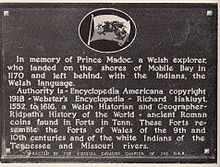By William Bruce
We find this legend an intriguing bit of local lore — and thought you might, too.
Ancient texts tell of Prince Madoc, an illegitimate but much-beloved son of a 12th Century ruler of Wales. According to legend, Madoc lost a quarrel with his brothers over his inheritance upon the death of his father.
Again according to legend, Madoc having nothing to lose gathered a group of fellow adventurers and set sail west from Wales on a venture of discovery. With favorable winds and currents – and a lot of luck – Madoc’s group landed on the shores of Mobile Bay in the year 1170.
Leaving most of his party in the new world, Madoc returned to Wales to recruit more colonists for another trip. With amazing stories of this newly discovered land, Madoc had no trouble gathering a large group and outfitting three ships for the return voyage. After sailing from Wales, the group was never heard from again, presumably lost at sea.
Meanwhile, the survivors that Madoc left in the Mobile area gradually migrated – or were driven by hostile Indians – up the major river systems of the country. Some historians maintain that the colonists evolved over the next several hundred years into the Mandan Indian Tribe of Missouri, an atypical tribe of “Indians” who used vestiges of the Welsh language and with some members of the tribe having light skin, red hair and blue eyes.
George Catlin, the Pennsylvania lawyer turned Indian painter who lived among the Mandans in the early 1800s, came to believe that they were descendants of Madoc’s group.
Other tantalizing clues in America lending credence to this legend are early Welsh artifacts found in the Southeast, a series of ancient fortifications of unknown origin but of peculiar Welsh design along the group’s supposed path of migration northward, and the accounts of early explorers of the American interior encountering “White Indians” speaking remnants of the Welsh language.
Proponents of the Madoc legend frequently quote John Sevier, the first governor of Tennessee. In 1782, Sevier visited the ruling Chief of the Cherokee Nation, Oconostota. Sevier asked Chief Oconostota about the curious ancient fortifications near Chattanooga along the supposed inland migration route of Madoc’s survivors.
The old chief told Sevier that the works had been made by the first white people who came to their lands from the Gulf of Mexico, into what is now Mobile Bay, and then up the rivers. According to Sevier’s writings, Chief Oconostota stated that “he had heard his grandfather and father say they were a people called Welsh, and they had crossed the Great Water in ships.”
Sevier also wrote in 1799 of the alleged discovery of six skeletons in brass armour bearing the Welsh coat-of-arms.
President Thomas Jefferson had heard enough about the “White Indians” to ask Lewis and Clark to keep an eye out for them.
None were encountered. But the legend lives on.
x x x
William “Will” Bruce is a resident of Fairhope, Alabama. Professionally, he is a mergers and acquisitions advisor, an Accredited Business Intermediary (ABI), and a Senior Valuation Analyst (SVA) assisting business buyers and sellers with the transfer of ownership. But this website is mostly about non-business local issues, events, and “stuff.” William may be reached by email at Will@WilliamBruce.org.
To subscribe to these ramblings, please see the subscription feature in the upper right part of this page.




Pingback: Did Jesse James practice medicine in Baldwin County, Alabama? | Flying Bridges & Hyperactive Azleas
Pingback: An Adventure Into Prehistoric Alabama | Flying Bridges & Hyperactive Azaleas
Pingback: What’s With Camden, Alabama? Is There Something in the Water? | Flying Bridges & Hyperactive Azaleas